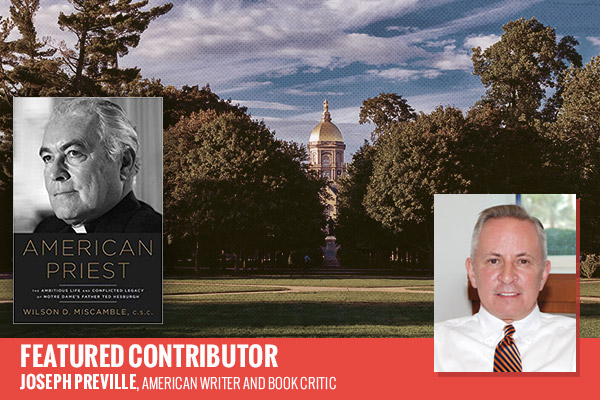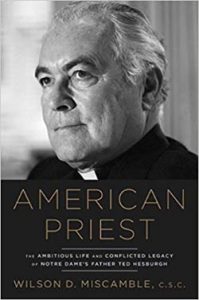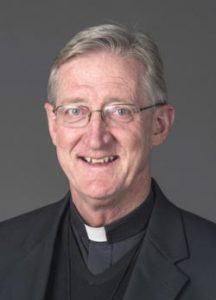
The Life and Legacy of Notre Dame’s ‘American Priest’, Father Hesburgh: An Interview with Fr. Wilson D. Miscamble, C.S.C.
- By Joseph Preville --
- 07 Jul 2019 --

In American Priest, Father Miscamble offers a three-dimensional portrait of Hesburgh as a Catholic priest, university president, and public servant.
Father Theodore Martin Hesburgh (1917-2015) was a giant among American Catholic educators in the twentieth century. As the 15th President of the University of Notre Dame (1952-1987), Hesburgh aimed high with bold and ambitious plans to build a great Catholic university in the heart of America. Did Hesburgh accomplish his lofty goal, or did he leave behind an unfinished project? University of Notre Dame historian Wilson D. Miscamble, C.S.C., Ph.D. takes a critical look at Hesburgh’s notable life and career in his new book, American Priest: The Ambitious Life and Conflicted Legacy of Father Ted Hesburgh (Image, 2019). Father Miscamble is the author of George F. Kennan and the Making of American Foreign Policy, 1947-1950 (Princeton University Press, 1992), From Roosevelt to Truman: Potsdam, Hiroshima and the Cold War (Cambridge University Press, 2006), and The Most Controversial Decision: Truman, the Atomic Bombs, and the Defeat of Japan(Cambridge University Press, 2011).
The Life and Legacy of Notre Dame’s ‘American Priest’, Father Hesburgh: An Interview with Fr. Wilson D. Miscamble, C.S.C.[/tweetthis]

Father Wilson D. Miscamble, C.S.C., Ph.D. discusses his new book in this interview.
Joseph Richard Preville: What inspired you to write a biography of Father Ted Hesburgh?

JRP: Hesburgh was a revered and iconic figure at the University of Notre Dame. How difficult was it to get behind the aura of his legacy?
WDM: I came at this study as a trained and (I hope) capable historian. I knew Fr. Hesburgh personally and, while I admired him, I also was able to see him as a real person and not just as a “living legend.” The fact that I was able to interview Fr. Hesburgh at length for this study also helped me to move beyond seeing him as an iconic figure. I was very conscious of getting past what might be termed the “learned hagiography” of much of the writing regarding Fr. Ted. I believe that he deserves a serious and critical reflection. I was willing in this study to address not only Fr. Hesburgh’s many strengths, but also to explore areas where his limitations are apparent. This is how good biography is written and I trust that my study is an example of the genre.
JRP: How did Vatican II shape Hesburgh’s vision for the University of Notre Dame as a great Catholic university?
WDM: Fr. Hesburgh saw himself as representing the Catholic Church in engaging a changing and complex world, and Vatican II was central in his thinking. He understood the call of the Second Vatican Council as guiding him in his work both at Notre Dame and beyond. In terms of his efforts at Notre Dame, he saw himself as enhancing the role of the laity in the administration of the university. He believed that his initiatives, such as transferring the ownership of the university from the Congregation of Holy Cross to a mixed board of lay and clerical fellows, was a fulfillment of the Second Vatican Council’s call for lay men and women to be more directly engaged in the Church. Furthermore, Hesburgh saw his efforts to develop the ecumenical institute at Tantur in the Holy Land as growing out of Vatican II’s concerns to build relationships with other Christians and, indeed, with other religions. Hesburgh’s friendship with Pope Paul VI reflected his appreciation that Paul was completing and implementing the work of Vatican II.
JRP: What role did Hesburgh play in the development of the 1967 “Land O’Lakes Statement”? Do Catholic educators still look back at that document for guidance or inspiration?
WDM: Fr. Hesburgh was a key figure at the Land O’ Lakes meeting in 1967. In his role as president of the International Federation of Catholic Universities, he convened the group that met in July 1967 in northern Wisconsin. He was influential in the discussions, although he did not draft the final document. Fr. Ted was very keen to forge a structure which would make American Catholic universities more acceptable to and more compatible with the major secular American institutions. Thus, he was eager to clarify that Catholic universities must not be subject to outside interference, including that of the Church itself. He remained throughout his life committed to this view. For him, Catholic universities had to be seen as independent from ecclesial authority and from their founding religious congregations so that they could be “genuine universities” first. At the same time, he still wanted universities like his to serve the Church and he would regularly proclaim that the Catholic university was where “the Church did its thinking.” Yet he never effectively reconciled how the very entity that supposedly did the Church’s thinking was somehow independent of it.
Many Catholic educators still do look back to Land O’ Lakes for guidance and seek to preserve their independence from the Church. This was certainly in evidence during the discussions that occurred to mark the 50th anniversary of Land O’ Lakes.
JRP: How did the University of Notre Dame’s relationship to its founding religious community, the Congregation of Holy Cross, change during Hesburgh’s tenure as president? Is there still a strong relationship between the two today?
WDM: The relationship between the University of Notre Dame and its founding religious community changed in a significant way under Fr. Hesburgh. Prior to the formal transfer in 1967, the Congregation of Holy Cross was not simply the founding Order but, in a legal sense, the owner of the university. This changed following upon a provincial chapter (meeting of the order) in 1967, but the transfer was not as dramatic as sometimes asserted by Fr. Hesburgh, who often said the transfer meant the university passed into “lay control.” But the new arrangements vested the ownership of the university in a Board of Fellows consisting of six Holy Cross priests and six lay persons. Nonetheless, these fellows elected a predominantly lay Board of Trustees and delegated important powers to it. Of course, the new arrangement also provided that the president of the university must be a Holy Cross priest.
There is indeed still a strong relationship between the university and the Congregation of Holy Cross. The University of Notre Dame is the most important ministry of the congregation and many Holy Cross priests serve at it. I hope and pray this will continue long into the future.
JRP: What were Hesburgh’s most important accomplishments outside his role as president of the University of Notre Dame?
WDM: Fr. Hesburgh’s renown owes much to his actions in the public sphere. No other priest served his nation so effectively over such a long period, spanning presidential administrations from Eisenhower’s through to Clinton’s. His involvements are all the more extraordinary in that he pursued them while still leading the university. His role was not one of spiritual guide or religious counselor to American leaders as in the manner of Billy Graham. Instead, he toiled tirelessly to aid the United States to resolve some of the major issues and challenges it confronted during this tumultuous time. Perhaps his most notable service came in the area of civil rights and through his membership on the Civil Rights Commission from 1957 until 1972. He worked hard to secure civil and voting rights for African Americans who had suffered long years of shameful discrimination. He also contributed significantly through agencies such as the Peace Corps during the Kennedy administration and the Presidential Clemency Board during the Ford administration.
JRP: How does the University of Notre Dame define itself as a Catholic institution today?
WDM: Notre Dame proclaims itself as a national Catholic research institution. Its leaders regularly assert that it must become a great Catholic university in a manner similar to the calls that Fr. Hesburgh made during his long tenure. But there is still some disagreement over what that should mean and what its implications are for how the university should operate. On some level the disagreement results from a lack of clarity over the relationship Notre Dame should maintain with the Church. If it adopts Ex Corde Ecclesiae as its guiding charter then Notre Dame should see itself as operating “from the heart of the Church” with all that implies. But if it holds to the declaration of “autonomy” from the Church as voiced in the Land O’Lakes statement its relationship will be more tenuous. How this crucial matter is ultimately resolved has major implications for a whole range of key areas including content of the curriculum and the composition of the faculty.
JRP: Could you recommend a few books on the history of American Catholic higher education?
WDM: Let me recommend three for you: 1) Philip Gleason, Contending with Modernity: Catholic Higher Education in the Twentieth Century (New York: Oxford University Press, 1995), 2) Alice Gallin, O.S.U., Negotiating Identity: Catholic Higher Education Since 1960 (Notre Dame; University of Notre Dame Press, 2000), and 3) James T. Burtchaell, The Dying of the Light: The Disengagement of Colleges and Universities from Their Christian Churches (Grand Rapids, MI.: Eerdmans, 1998).


















